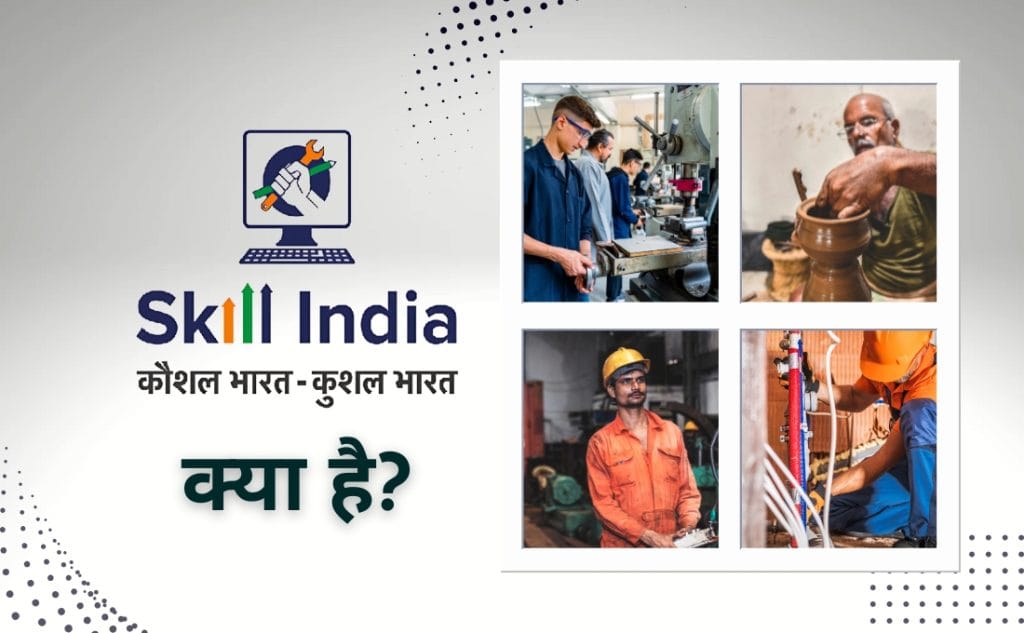India is one of the youngest nations in the world. A significant proportion of its population falls under the age of 35, with more than 54% of the total population below 25 years of age. However, this demographic dividend stands at the risk of being wasted if the youth of the country does not develop proper skills. According to reports, India’s formally skilled workforce is only around 2%, which is much below the global average. This skill gap, together with the disruptions caused by technological shifts, creates a situation where high unemployment is accompanied by the gap between the skilled labour force that is in demand and the actual labor force. As a response to this challenge, Government of India initiated the Skill India Mission.
Skill development of the new generation is a national need and is the foundation of Aatmnirbhar Bharat – Shri Narendra Modi
Skill India Mission is an all-encompassing initiative devised to fill the increasing skill gap in the country by providing millions of people with vocational training and skills development opportunities. The mission plans to prepare the Indian workforce for the obstacles in the emerging global economy. The aim of Skill India initiative is to transform the face of education, employment, and economic growth for India.
Let’s explore in detail what Skill India Mission entails, its objectives, various programs and schemes under this mission.
What is the Skill India Mission?
 In 2015, Prime Minister of India, Narendra Modi, launched Skill India Mission. This is an ambitious government initiative aimed at empowering the youth of India by providing them with the necessary skills that are industry relevant. This mission is directed to deliver vocational training and skill development courses in sectors of high growth within India and beyond.
In 2015, Prime Minister of India, Narendra Modi, launched Skill India Mission. This is an ambitious government initiative aimed at empowering the youth of India by providing them with the necessary skills that are industry relevant. This mission is directed to deliver vocational training and skill development courses in sectors of high growth within India and beyond.
With a goal to provide quality training to young people, Skill India Mission has been devised to ensure that they are equipped with occupationally- aligned skills. It focuses on diverse sectors, ranging from agriculture, manufacturing and healthcare to IT, AI, drones, robotics and other futuristic technologies. The training is provided in the mentioned sectors and helps prepare India’s youth for future challenges while contributing to the economic growth of the nation.
Besides enhancing employability, Skill India Mission is also making certain that youth gain the skills required to become job creators, entrepreneurs and contributors to the global economy.
Why Does India Need the Skill India Mission?
India is at the cusp of a demographic dividend, with a large, youthful population ready to enter the workforce. However, several challenges stand in the way of harnessing the full potential of this young labour force:
According to the International Labour Organisation, India is likely to face a shortage of ~29 million skilled personnel by 2030.
- Skill Gap: A report published in 2014 showed that only 2% of India’s workforce is formally skilled. In contrast to this, developed countries like Germany have a 75% skill training rate, Japan at 80%, and South Korea at 96%. Lack of vocational training and professional skills causes high unemployment as youth cannot get jobs according to their qualifications.
- Mismatch of Skills and Employment Needs: For most of these youths, skills and jobs do not seem to match perfectly. Many young people complete schools and colleges without any on-the-job training or industry experience. As a result, they are unable to meet the demands of employers who are looking for job-ready candidates. The employment crisis is only worsened because of the mismatch between the skills that the youth possess and those required by industries.
- Technological Advancement: Introduction of new technologies such as artificial intelligence, robotics, and automation has changed the skill sets required by employers. Workers need to constantly upgrade their skills to remain relevant in the job market.
- Changing Demographics: India’s youth population will remain an asset for the next few decades, but only if it is equipped with the necessary skills. Training and education programs that focus on the demographic dividend will help ensure that India’s young workforce is employable.
FREE DATA SCIENCE COURSE
FREE CYBERSECURITY COURSE
FREE BANKING COURSE
What are the Objectives of the Skill India Mission?
Skill India Mission aims to skill 40 crore (400 million) people in India in various skills. The mission is looking into various initiatives and frameworks intended to provide vocational training and industry-specific skills. The objectives of the Skill India Mission include:
- Closing the Skill Gap: Main objective of the mission is to bridge the gap between the skills required by industries and the skills possessed by workers. The mission ensures that young people are trained in areas that align with current and future industry needs.
- Improve Employability: The mission strives to enhance the employability of the youth. This is achieved through equipping them with the skills to succeed in the workforce. For this purpose, it offers training programs that are in accordance with market demands.
- Entrepreneurial Orientation:It aims at developing entrepreneurial spirit among the youngsters of the country. The mission gives them the resources, knowledge and skills required for the initiation of entrepreneurship activities as job providers instead of being job seekers.
- Increasing Global Competitiveness:By delivering skills which are internationally accepted, Skill India Mission helps increase India’s global competitiveness such that Indian workforce will become internationally proficient. The goal is to ensure that Indian workers can work not only within India but also in foreign markets.
- Promoting Industry Diversification: Mission further highlights the scope of skilling and up-skilling in other diversified sectors, ranging from manufacturing and IT to agriculture and healthcare, as well as the building and hospitality industry. . Prioritizing new sector-based technology like AI, drones and robotics will catapult India as an world leader of tech innovation.
- Creation of sustainable jobs:Lastly, this initiative is not only to provide short-term jobs but also generate sustainable, long-term career opportunities leading to the overall economic growth of India.
What are the Main Features of Skill India Mission?
- Focus on Industry-Relevant Skills:Compared to the other conventional education system that focuses primarily on theoretical knowledge, Skill India Mission stresses the importance of acquiring practical skills, which would be highly relevant in industries. Such training programs emphasize providing hands-on experience and creating industry-specific competencies.
- Global Standards:Skill India Mission focuses on providing training that meets global standards so that Indian youth can compete better in foreign markets and fulfill the skill demands of MNCs.
- Integration of Vocational Education into Mainstream Education:The mission involves integration of vocational education in mainstream education system. Through partnership with educational institutions like school, college and universities, Skill India Mission ensures that vocational training forms part of a student’s academic journey.
- Reach the Marginalized Communities:Mission also gives special emphasis to the skill development opportunities for women, SC/ST communities and people from rural areas. This inclusivity ensures that no one is left behind in the pursuit of economic empowerment.
- Building Robust Infrastructure:The mission is also about creating state-of-the-art training facilities such as Pradhan Mantri Kaushal Kendras (PMKK) and National Skill Development Centers (NSDC), equipped with modern technologies and industry-standard tools. National Skill Development Corporation (NSDC) is the principal architect of the skill ecosystem in the country, with mission to Skill/Reskill/Upskill 25 Mn Individuals.
- Entrepreneurship Development:Initiatives such as Pradhan Mantri YUVA (PM YUVA) Yojana by the Skill India Mission help create an entrepreneurial culture by providing training and support to young entrepreneurs.
What are the Various Government Schemes under the Skill India Mission?
Government of India has introduced several key schemes to support the Skill India Mission and make it effective across the country:
Pradhan Mantri Kaushal Vikas Yojana (PMKVY)
This is the flagship program under the Skill India Mission. PMKVY is designed on offering short-term trainings in building, electronics, healthcare, automobile engineering, among others. 4th phase of PMKVY was announced by the government back in 2023. It is dedicated to train youth in futuristic areas such as AI, robotics, mechatronics, and drones..
National Apprenticeship Promotion Scheme (NAPS)
NAPS promotes apprenticeship training in India. This scheme provides on-the-job training to the youth of the country so that they may gain practical experience in different fields. This scheme is very helpful in developing a skilled workforce and reducing the employability crisis.
Skills Acquisition and Knowledge Awareness for Livelihood Promotion (SANKALP)
SANKALP is the World Bank-aided project that focuses on the improvement of institutional frameworks, quality of training and skill development programs, which are in tune with market requirements. It is majorly focused towards upgradation of skills of marginalized communities.
Jan Shikshan Sansthan (JSS)
It extends vocational training to non-literate, neo-literate and dropout individuals. Main objective of this scheme is to improve the skills of those who are excluded from formal education and secure their integration into the economy.
Pradhan Mantri Kaushal Kendras (PMKK)
Pradhan Mantri Kaushal Kendras are high-tech trainings centers designed to impart best training to the youth with all modern infrastructural facilities to provide hands-on training in high-demand sectors.
What is Skill India Digital Hub?
Skill India Digital Hub (SIDH) is a transformative platform designed to skill, reskill and upskill Indian citizens through online training, trusted credentials and access to job and entrepreneurial opportunities. Started by Government of India in September 2023, SIDH bridges the gap between employees, employers and educational institutions by connecting major government portals like Udyam, e-Shram, NCS and ASEEM.
Since its inception, the Skill India Digital Hub has garnered significant engagement, with over 60 lakh learners registered.
SIDH acts as DPI or Digital Public Infrastructure for the Indian skilling ecosystem. This platform provides equitable access to skill development resources and integrates stakeholders from both public and private sectors. It has been established in order to promote a culture of lifelong learning as well as continuous upskilling, accessible to every individual belonging to a variety of backgrounds for growth as well as development opportunities.
Skill India Digital Hub is scalable and interoperable in nature that would strengthen the skilling, employment and entrepreneurship initiatives in the country by adding efficiency. It is important for future-proofing of the Indian workforce, by offering futuristic courses and leveraging data-driven decision-making. This is a holistic platform and acts as a vital means to ensure the competitiveness of Indian workforce internationally, while concurrently promoting economic and social development.
Through the Skill India Digital Hub, India is taking a big step towards building a skilled workforce that can face the challenges of the digital age and participate in the global economy.
Three-layered framework of Skill India Digital Hub
The platform is structured around a three-layered framework that ensures the seamless delivery of its services:
- Trust Layer:Portable, permanent and inclusive verifiable digital credentials. This layer utilizes electronic registries in a way that a single source of truth regarding the skills is ensured, enhancing the credibility of the credentials.
2. Finance Layer:It enables direct beneficiary transfers, rewards and scholarships, thereby enabling individuals to access financial support for skill development opportunities.
3. Discovery Layer: This layer helps users discover courses, training centers and job opportunities. It encourages innovation by helping users explore new services and products within the skilling ecosystem.
Skill India Digital Hub User Base
Skill India Digital Hub addresses the needs of users at each stage of learning and professional pursuits:
- Students: Currently engaged learners can benefit from further training in skills through this platform complementing their primary education.
- Early Exits from Education: Those who could not continue studies beyond a few years can seek skill-based training to re-enter the workforce.
- Completed Education: Those who completed their education can look for upgradation in skills and secure better job.
- In-Service: Current employees seeking improvement in skills to meet changing industry demands.
- Not in Employment, Education, or Training (NEET): These are individuals who are not currently in work or education can use the platform to explore career opportunities.
What are the major Highlights of Skill India Digital Hub?
The platform provides a wide range of services to improve the learning and career journey of its users:
- Discovery
- Free Content and Services: Users can access a wide range of free resources, such as learning materials and services that can help them grow in their careers.
- Success Stories: The site has a set of success stories to inspire learners and trainers.
- Courses, Centers and Employers: Users can find courses, training centers and employers relevant to their interests, location and aspirations.
- Recommendation
- Course and Center Location: Platform uses inherent ML algorithms to suggest the most suitable courses and training centers based on learners’ profiles.
- Course Type, Fee, and Duration: Learners are given the facility to filter courses on the basis of delivery methods (classroom, digital or hybrid), fee structure and duration.
- Ratings and Reviews: Users can review and rate courses, trainers and centers to help other people make the right choices.
- Employment and Apprenticeship: The site also provides job opportunities and apprenticeships in line with profile of the learners.
- Skilling
- Master List of Courses: Participants are provided with a master catalogue of courses that contains course descriptions, NSQF levels, as well as the skills to be acquired.
- Anytime, Anywhere Learning: Skill India Digital Hub is providing digital learning materials available on different devices through which learners can study at their will.
- Lifelong Learning
- Alumni Network: Students can connect with alumni and get information about career paths and industry trends.
- Mentorship and Coaching: The platform facilitates mentorship opportunities, enabling learners to grow professionally through guidance from experienced mentors.
- Apprenticeship:
- On-the-Job Learning: Students can participate in apprenticeships that give them hands-on experience and practical skills.
- Earn While Learning: Apprenticeships also give learners an opportunity to earn an income while acquiring skills.
- Assessment:
- Assessment on Demand: Participants, after completing their training, can connect with assessors to validate their skills through assessments.
- Assessor Ratings: Users can rate their assessors, helping others choose the right one for their assessment needs.
- Learning Management System (LMS):
- Online Classes: SIDH offers free and paid online classes that can be accessed from anywhere.
- Practice Test and Quiz: This platform provides quizzes and practice tests for the students to evaluate if they are in a position to comprehend the subject.
How SIDH is Bridging the Skills Gap?
Skill India Digital Hub works on bridging the widening skills gap in India. Industry 4.0 demands higher technical competence in the country. This digital platform addresses this need by offering courses in big data, artificial intelligence, cybersecurity and other cutting-edge technologies.
The platform besides preparing people for future industries supports small business entrepreneurs. SIDH helps entrepreneurs grow their businesses and access new markets, by partnering with initiatives like UdhyamKart from NIESBUD.
SIDH Collaborations with Industry and Educational Institutions
Skill India Digital Hub partners with other industry leaders and educational institutions so that the courses offered are in line with industry requirements and have high quality. The industry leaders and institutions include Cisco, Microsoft, Tech Mahindra, and NSDC among others. Contents of the portal are also updated based on the recent trends in industries.
SIDH, through its engagement with SSCs and Ed-tech platforms, ensures that the content delivered is industry-aligned, thereby making learners job-ready and prepared for future challenges.
What is the significance of Obtaining Skill India Certificate?
Skill India certificate is of great value as it certifies the industry-aligned skills of an individual, thereby enhancing employability and career prospects. It is accepted by employers for job purposes or entrepreneurship. The certificates are issued by various Indian government ministries and are also ISO 9001:2015 Certified, thus ensuring that they meet international standards and regulatory requirements. This certification adds to the credibility both nationally and internationally.
India’s National Skill Development Mission 2025
As on August, 2024; the number of beneficiaries trained under different schemes of Ministry of Skill Development and Entrepreneurship is
| 1. | PMKVY(since inception (2015-16) to June, 2024) | 1,48,11,506 |
| 2. | JSS (since 2018-19 to June, 2024) | 26,38,028 |
| 3. | NAPS (since 2018-19 to June,2024) | 29,91,072 |
| 4. | CTS (since 2018 to 2023) | 79,51,834 |
Conclusion
Government of India established Skill India Mission to skill the people of the country and make India’s workforce capable of driving its economic growth. The mission is delivered through programs like PMKVY, NAPS and SANKALP, which fill skill gaps, promote entrepreneurship and promote inclusive development. Skill India Digital Hub (SIDH) further enhances digital training, supporting India’s growth in the digital economy. With government support and sector collaboration, the mission is empowering youth thereby building a prosperous future for India.
References:-
https://www.skillindiadigital.gov.in
https://nstiwnoida.dgt.gov.in
https://skillindiamission.in
https://skillindia.gov.in
https://nsdcindia.org
https://www.ibef.org/government-schemes/skill-india
https://www.indiabudget.gov.in/
https://pib.gov.in/PressReleasePage.aspx?PRID=2053796










